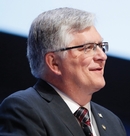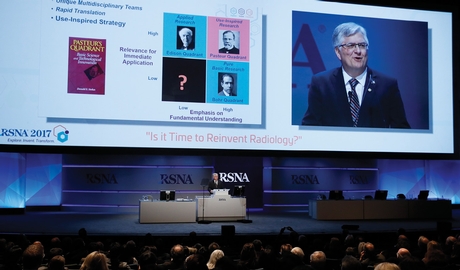Continued Reinvention of Radiology can Transform the Profession
Monday, Nov. 27, 2017

Ehman
The greatest opportunity and most urgent need facing radiology is to innovate the practice to optimize value, according to RSNA President Richard L. Ehman, MD.
"No other major medical specialty is so profoundly based on a remarkable invention that changed the world," Dr. Ehman told the audience in Arie Crown Theater for Sunday's Opening Session. "And it is your collective focus on the well-being of our patients that drives all of our efforts and innovations."
In his President's Address, "Is it Time to Reinvent Radiology?" Dr. Ehman reflected on the theme of this year's annual meeting to discuss how the lessons from the past can help advance the unique aspects of radiologic science that are driving the innovations of tomorrow. "It is time to explore the frontiers of our discipline to support our culture of invention that will ultimately help transform what we do to better serve our patients," he said.
From the earliest days of medical imaging, exploring the possibilities of radiography has had an extraordinary impact on patient care. In fact, expanding the capabilities of medical imaging has changed patient care so greatly that most physicians cannot imagine practicing without them.
"It is the very exploration by multidisciplinary teams of physicists, engineers, radiologists and chemists that resulted in the innovations that went far beyond the original inventions," Dr. Ehman said. "This 'use-inspired' mindset in radiology still encourages research that integrates basic and applied science from the onset to help explore the potential of an invention resulting in high impact on patient care."
Dr. Ehman emphasized the rapid translation of medical imaging research and advances into clinical practice. "Radiologists are fierce early adopters of new technology when they believe it can improve the service they provide for patients," Dr. Ehman said.
Dr. Ehman offered several ways that radiologists can tap the full potential of radiology to achieve the transformations that will lead into the next decades and beyond. First, radiologists must continue to recognize and capitalize on the unique aspects of the science.

RSNA President Richard L. Ehman, MD, addresses annual meeting attendees at Sunday's Opening Session.
"Research in our field is typically use-inspired and rapidly translated for high impact on patient care," Dr. Ehman said. "Our advances are often in the form of inventions and our innovation is fueled by technology. And radiology research often harnesses multidisciplinary team science and yields a high return-on-investment by economic standards."
Second, radiologists must continue to relentlessly innovate, especially focusing on investing in research, which in radiology has been shown to have a very high rate of return. "Some have wondered if we are reaching a technological plateau in medical imaging," he said. "Yet, if you look at the exploding content of our journals and the vibrant innovation displayed in the scientific sessions and the technical exhibition of this annual meeting, you will see that this is simply not the case."
As a third area of focus, Dr. Ehman noted that radiologists must continue to strive for innovation around value in medical imaging. While the current perceived value of medical imaging merits excellent reimbursement within the traditional fee-for-service practice, it is now time to be proactive in adopting innovations that enhance value even if they disrupt the fee-for-service model. "These innovations — whether they are machine learning, highly-focused protocols or value-focused re-engineering — may allow our most powerful diagnostic tools to be used even more effectively for the benefit of patients," he said.
In conclusion, Dr. Ehman asked members to embrace disruption and continue to reinvent and transform the specialty to provide patients with access to radiology's strongest capabilities. "Imagine a world in which our most advanced imaging technologies are widely available, modestly-priced and considered high-value, first-line diagnostic tools," he said. "Knowing that disruption and reinvention of our practice is inevitable, we must guide the process ourselves instead of having it imposed on us by others outside our discipline."




 Home
Home Program
Program
 Exhibitors
Exhibitors My Meeting
My Meeting
 Digital Posters
Digital Posters Case of Day
Case of Day

